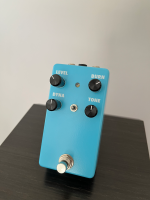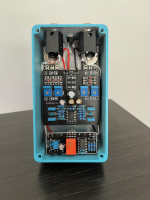- Build Rating
- 5.00 star(s)
I'm way behind on posting build reports and figured I'd start with this one since it's probably my favorite pedal that I've built over the last few months. I decided to try it mostly on a whim: the clipping topology appealed to me (feedback loop clipping followed by diodes to ground, with variable resistance in series with the latter) but otherwise I had no specific expectations.
Wow! So many great sounds to be had. I can't decide if I like it better as a very light drive to get some transparent/unobtrusive compression+grit (useful when I can't turn my amp up as loud as I'd like — which is to say, most of the time ), or as a medium-high gain drive that's very warm and thick while still remaining articulate. David Barber talks about the importance of chord clarity in his pedal voicing, and that approach is really apparent here.
), or as a medium-high gain drive that's very warm and thick while still remaining articulate. David Barber talks about the importance of chord clarity in his pedal voicing, and that approach is really apparent here.
There are so many different and satisfying textures to be had by varying the Burn and Dynamics controls... speaking of which, the one thing that confused me at first is that the Dynamics control seems to work backwards compared to the original pedal. Disclaimer: I've never played an actual Small Fry but based on the manual and some demos I watched, the original gets more compressed in the CCW direction, whereas the Tater Tot gets more compressed in the CW direction. Really not an issue, and it kind of makes sense if you think of it as a "Compression" control rather than Dynamics.
Another note: I didn't have any Ge diodes on hand so I used BAT41s. I run the Dynamics control pretty low (more resistance in series with the diodes), so I'm not sure that this would make much of a difference.
All in all, fantastic pedal and kudos to Mr. Barber (and @Robert of course for this layout that fits in a more pedalboard-friendly box)!


Wow! So many great sounds to be had. I can't decide if I like it better as a very light drive to get some transparent/unobtrusive compression+grit (useful when I can't turn my amp up as loud as I'd like — which is to say, most of the time
There are so many different and satisfying textures to be had by varying the Burn and Dynamics controls... speaking of which, the one thing that confused me at first is that the Dynamics control seems to work backwards compared to the original pedal. Disclaimer: I've never played an actual Small Fry but based on the manual and some demos I watched, the original gets more compressed in the CCW direction, whereas the Tater Tot gets more compressed in the CW direction. Really not an issue, and it kind of makes sense if you think of it as a "Compression" control rather than Dynamics.
Another note: I didn't have any Ge diodes on hand so I used BAT41s. I run the Dynamics control pretty low (more resistance in series with the diodes), so I'm not sure that this would make much of a difference.
All in all, fantastic pedal and kudos to Mr. Barber (and @Robert of course for this layout that fits in a more pedalboard-friendly box)!


Last edited:

